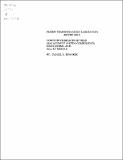Competitive impacts of yield management system components : forecasting and sell-up models
Author(s)
Skwarek, Daniel Kew
DownloadFTL_R_1996_06.pdf (15.46Mb)
Other Contributors
Massachusetts Institute of Technology. Flight Transportation Laboratory
Metadata
Show full item recordAbstract
The focus of revenue management research efforts has historically been on the development of seat optimizers which find revenue maximizing booking limits by fare class in a nested fare class structure. Significantly less attention has been devoted to the input methodologies which provide information to the seat optimization algorithm, which is then used to calculate booking limits. Among these inputs are a forecasting method and detruncation method. The forecaster provides the seat optimizer with estimated mean unconstrained bookings and standard deviation by fare class for a forecast flight. The detruncator adjusts data from historical flights used by the forecaster which have constrained booking information because they have reached booking limits. A third optional input methodology is an adjustment within the seat inventory control process (either to booking data or booking limits provided by the seat optimization algorithm) to account for the possibility of passenger sell-up to a higher fare class when the initially-desired class has been closed. This adjustment has the effect of inducing more sell-up. Using PODS (a comprehensive simulator of passenger behavior and seat inventory control in a fully competitive framework), this thesis compares pickup, regression, and "efficient" forecasting on a revenue basis. Similar comparisons are performed for no detruncation, booking curve detruncation with and without scaling, projection detruncation, and pickup detruncation. Finally, a modified booking limit strategy to induce sell-up introduced by Belobaba and Weatherford is tested. All tests are performed under a variety of environmental conditions. Forecasting results indicate that the efficient forecaster is nearly always revenue inferior to pickup forecasting. Neither regression nor pickup forecasting were unambiguously superior: The relative performance of these two forecasters is dependent on detruncation method choice and environmental conditions. Among detruncation methods, not detruncating or pickup detruncation is inferior. Scaling the booking curve used for detruncation yielded superior revenue results over not scaling, and projection detruncation always performed at least as well as booking curve detruncation without scaling. Sell-up tests indicate significant revenue gains to estimating sell-up probabilities. Revenue gains are limited if competitors cannot collude, many alternative flights exist, or passengers have low willingness to pay for higher-valued fare classes.
Description
Cover title Includes bibliographical references (p. 192-195)
Date issued
1996Publisher
[Cambridge, Mass. : Massachusetts Institute of Technology], Flight Transportation Laboratory, [1996]
Other identifiers
663473380
Series/Report no.
FTL report (Massachusetts Institute of Technology. Flight Transportation Laboratory) ; R96-6
Keywords
Airlines, Airplanes, Management, Seats, Rates